Physical Address
304 North Cardinal St.
Dorchester Center, MA 02124
Synovial-based lesions encompass both reactive and neoplastic processes. Although any joint may be affected, the most common site of disease is the knee. Pathologic changes in the small joints of the fingers are typically due to rheumatoid disease or localized tenosynovial giant cell tumor, whereas changes in the ankles and wrists may be due to intra-articular diffuse tenosynovial giant cell tumor. Malignant lesions of the joints are uncommon but well described.
Rheumatoid disease is a chronic, systemic, autoimmune disease that primarily affects the joints (rheumatoid arthritis [RA]) and periarticular tissues but that is also associated with extra-articular manifestations. RA was initially recognized as a distinct entity by Dr. Landré-Beauvais, who differentiated it from common gout in his doctoral dissertation in 1800.
Although the etiology of rheumatoid disease is not completely understood, both environmental and hereditary factors are clearly involved. Familial clustering and concordance in monozygotic twins brought early recognition to the importance of a genetic component, and a correlation between human leukocyte antigen (HLA) type and the development of RA was identified in the 1970s. Although other candidate gene polymorphisms have been identified, particularly using genome-wide association studies, the strongest link is with HLA-DRB1.
RA has an incidence of approximately 38 cases per 100,000 and a prevalence of approximately 10.7 cases per 1000 people in North America. There is a strong female predominance, with a female-to-male incidence ratio of approximately 2 : 1. RA affects patients of all ages but is most common in the fourth to the sixth decades of life.
RA is a polyarticular, often symmetric process that is most common in the small joints of the hands, feet, and cervical spine; however, larger joints such as the knee and shoulder may be affected. The joints are typically warm, swollen, and painful in large part due to effusions that have a high protein content and a milky appearance. The proportion of neutrophils is significantly lower than that seen in septic arthritis.
Inflammatory destruction of the articular cartilage may result in joint fusion or, if the tendons, ligaments, and joint capsule are affected, joint instability and subluxation. In contrast to degenerative osteoarthritis, RA appears to have a circadian rhythm, with pain and stiffness generally greater in the morning. Because rheumatic disease is a systemic disease, extraskeletal manifestations are common and include inflammation of the vessels, pleura, and pericardium as well as rheumatoid nodules in the soft tissue.
In the early stages of the disease, imaging studies may be inconclusive and show only localized soft tissue swelling, marginal erosions, and periarticular osteopenia. With progression of the disease, however, destruction of the joints with associated bone resorption can be easily visualized on conventional radiographs ( Fig. 21-1 ). Magnetic resonance imaging (MRI) may be useful in confirming extraskeletal disease.
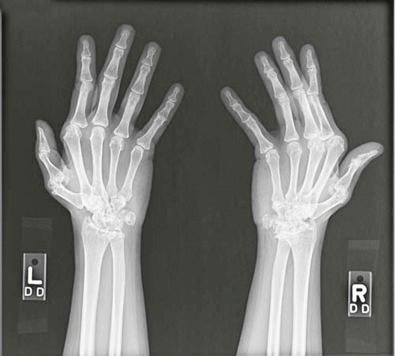
In the event of arthroplasty, the resected joint is characterized by hyperplastic synovium that has a papillary architecture and that may have a reddish tinge due to previous hemorrhage. In more advanced cases, the synovium may extend over the articular cartilage, which can display significant erosive changes. Joint fusion is a less common finding.
The synovium in RA is characterized by chronic, nonsuppurative, proliferative synovitis. Hypertrophy and hyperplasia of the synovial lining cells results in villous formation similar to that seen in pigmented villonodular synovitis (PVNS) ( Fig. 21-2 ). Lymphocytic aggregates are common and, in the subintimal region, a mixed inflammatory infiltrate composed of plasma cells, lymphocytes, and mast cells predominates ( Fig. 21-3 ). Multinucleated giant cells can also be seen either in this area or deeper in the synovium, and fragments of eroded bone may be incorporated into the synovium.
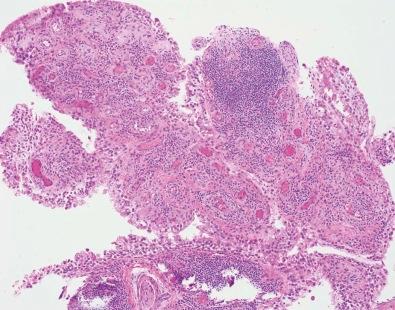
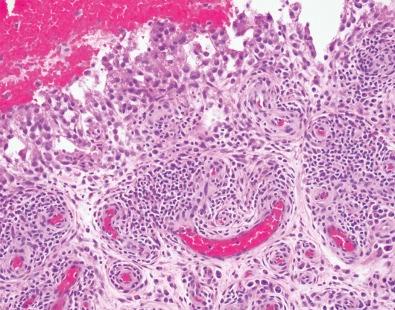
The synovium may eventually extend over the articular cartilage, forming a pannus. This inflamed synovium may destroy the underlying cartilage by actively degrading the tissue as well as by preventing adequate nutritional support.
The subchondral bone also shows pathologic findings, including extensive chronic inflammation, which may attack the overlying articular cartilage, along with lymphoid aggregates and occasional foci of necrosis.
Degenerative arthritis can usually be excluded by both clinical and histologic features. Although chronic inflammation may be seen in degenerative arthritis, the abundant plasma cells and pannus formation seen in RA are absent. Secondary degenerative changes are common in the setting of RA, and it is easy to overlook RA in this context.
Acute RA may have a significant component of neutrophils trapped within the fibrinous exudates. An infectious etiology can be excluded by microbial culture and clinicoradiologic correlation.
A serum test for rheumatoid factor, an antibody against the Fc portion of immunoglobulin G, is positive in approximately 80% of patients with RA. However, this test is also positive in other connective tissue diseases such as Sjögren syndrome and systemic lupus erythematosis. Antibodies to cyclic citrullinated peptide are more specific for RA. Culture of the synovial fluid can help exclude inflammatory arthritides.
RA is a non-neoplastic condition that, nonetheless, has a strong hereditary component. Genome-wide association studies have identified more than 30 RA susceptibility loci; however, these are believed to account for less than 50% of the total genetic heritability. HLA-DRB1 and PTPN22 have been implicated in severe RA characterized by autoantibodies to cyclic citrullinated peptide.
There is no cure for RA, and treatment focuses on managing symptoms and slowing disease progression. Typically, drugs that reduce pain and inflammation (e.g., aspirin, corticosteroids) are combined with disease-modifying anti-rheumatic drugs, medications that moderate disease progression and reduce joint destruction (e.g., methotrexate, hydroxychloroquine). Surgery may be necessary in cases of severe joint destruction.
For an additional discussion of rheumatoid disease, see Chapter 19 .
Synovial hemangioma was initially described in 1856 by the French physician Eugène Bouchut in his treatise on erectile tumors of the knee. The first significant clinicopathologic study of the entity was published by the surgeons George Bennet and Milton Cobey in 1939; they presented 5 of their own cases and reviewed 24 cases from the literature. They were the first to suggest categorizing synovial hemangiomas as diffuse versus localized lesions. In 1993, a large series of 20 cases retrieved from the files of the Armed Forces Institute of Pathology over a 25-year period clarified clinicopathologic parameters and the differential diagnosis of synovial hemangioma. In addition, this study also argued against a biological relationship with PVNS, now better termed “diffuse tenosynovial giant cell tumor.”
Synovial hemangioma is a rare, monoarticular lesion that generally arises in the knee joints of children and adolescents. The second most common site is the elbow, with few cases described in the fingers. There is a slight male predominance.
The typical clinical presentation is relatively nonspecific, and delay in diagnosis is common. A long history of a painful swelling of the knee with or without an obvious mass, recurrent joint effusions, and hemarthrosis are common presenting symptoms. Atrophy of the thigh muscles has also been described.
Synovial hemangiomas may be either localized or diffuse and are typically restricted to the synovial space. Conventional radiographs are often nondiagnostic, although phleboliths may suggest the diagnosis ( Fig. 21-4A ). MRI evaluation shows enhancement in both T1- and T2-weighted images and may be pathognomonic for localized hemangiomas as a lobulated intra-articular mass with these signal characteristics (see Fig. 21-4B ). This modality is also useful in delineating the tumor extent for surgical planning.
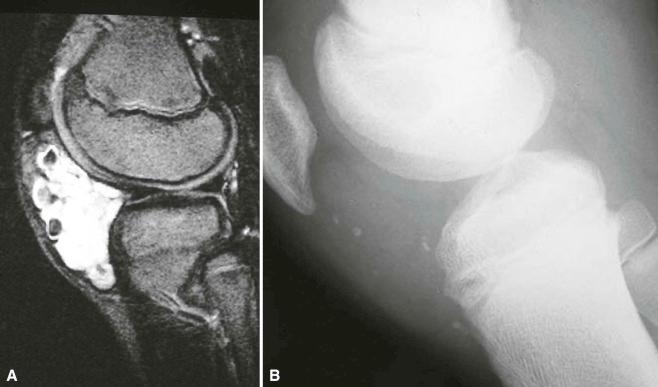
Grossly, localized synovial hemangiomas typically have a pedunculated appearance, whereas diffuse lesions can display villous hypertrophy and abundant hemosiderin deposition.
Histologic patterns include cavernous, capillary, and mixed hemangiomas. Although earlier work suggested that diffuse synovial hemangiomas are typically of the cavernous type and localized synovial hemangiomas are more often of the capillary type, the most recent large series did not support this. The authors did not specifically address hemangioma histology according to lesion extent. However, 70% of the lesions were localized, and only 25% of the cases were considered capillary hemangiomas.
Most synovial hemangiomas display cavernous histology consisting of thin-walled, dilated vessels identical to those seen in their soft tissue counterpart ( Fig. 21-5 ). In contrast, capillary synovial hemangiomas are composed of small, capillary-sized vessels arranged in a lobular architecture. Hemangiomas showing a mixed pattern of thick- and thin-walled vessels have been called “arteriovenous” hemangiomas and are the least common.
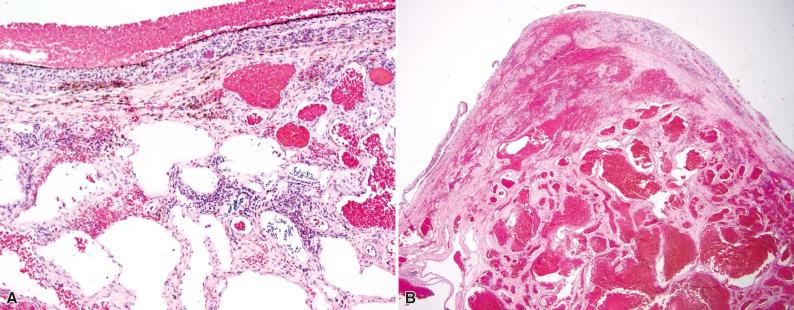
The overlying synovium shows reactive changes, including villous hyperplasia and, in the setting of frequent bleeds into the joint space, abundant hemosiderin deposition. Hemosiderin can be found in both superficial and deep synovium and may have a patchy distribution. Lymphoid follicles are rare and myxoid stromal change is uncommon.
Clinically, a diagnosis of lipoma arborescens, nonspecific synovitis, or intra-articular tenosynovial giant cell tumor may be suggested. The histologic differential diagnosis shows some overlap and includes nonspecific synovitis, soft tissue hemangioma/angiomatosis, organizing hemorrhage, and PVNS.
Although lipoma arborescens may be considered clinically because it, like synovial hemangioma, is bright on T1 and T2 imaging, these two entities are easily distinguished histologically. Nonspecific synovitis is both a clinical and histologic consideration; an associated reactive vascular proliferation and/or increased vessel prominence secondary to myxoid change in the surrounding stroma may resemble synovial hemangioma. Perivascular myxoid change is uncommon in true synovial hemangiomas and is a useful point of distinction.
Hemangiomas of soft tissue extending into the joint may mimic a synovial hemangioma. Joint involvement can also be rarely seen in hemangiomatosis; this possibility should be ruled out by clinical and radiologic evaluation due to the high rate of local recurrence of this entity. Organizing hemorrhage, particularly when sited in a papillary frond of synovium, can resemble synovial hemangioma but lacks an associated vascular network.
PVNS is perhaps the most challenging and most critical entity to exclude because it may mimic a diffuse synovial hemangioma radiologically, grossly, and, in cases with abundant hemosiderin and clefting, microscopically. However, synovial hemangiomas lack the characteristic monocytes and multinucleated giant cells seen in PVNS. Immunohistochemical stains for endothelial antigens (e.g., CD31, CD34) will be positive in synovial hemangiomas but negative in the lining cells of the slitlike spaces seen in PVNS.
Synovial hemangiomas are benign lesions. However, when they are symptomatic, complete local excision is warranted. Pedunculated lesions can usually be treated arthroscopically, but more diffuse lesions may require arthrotomy.
The term “lipoma arborescens” was first used to describe this condition in 1838 by Johannes Müller. At the time, these lesions were considered by many to be secondary to tuberculosis; however, in the late 19th century, Schuchardt was able to demonstrate that the hyperplastic synovium did not have microscopic features of tuberculosis and was probably reactive in nature. This theory gained credence with Albert Hoffa's description of adipose tissue in the pathologic knee joint and, although the exact etiology of lipoma arborescens is unclear, most current authors support a reactive origin. Consequently, terms such as “villous lipomatous proliferation of the synovial membrane,” “synovial lipomatosis,” and “synovial lipomatosis arborescens” that reflect the non-neoplastic etiology of this lesion have been proposed; however, they have not been widely adopted.
Lipoma arborescens is a rare lesion that is most common in adult males in the fifth to seventh decades. However, pediatric cases have also been described.
Lipoma arborescens usually presents as a monoarticular disease affecting the knee joint, particularly the suprapatellar pouch. Cases have also been described in the hip, ankle, shoulder, elbow, and wrist joints. In addition, cases involving the synovial sheaths surrounding tendons and bursae have been described. Typically, patients present with a gradual increase in swelling around the joint with an associated effusion. Multifocal lipoma arborescens is uncommonly described.
Lipoma arborescens can often be diagnosed based on imaging studies. Although plain radiograph studies are nonspecific, high signal intensity in both T1- and T2-weighted images with decreased signal intensity on fat-suppressed sequences is a hallmark of this entity ( Fig. 21-6 ). Ultrasound analysis shows a hyperechoic mass with fronds of tissue that wave in real time during joint manipulation.
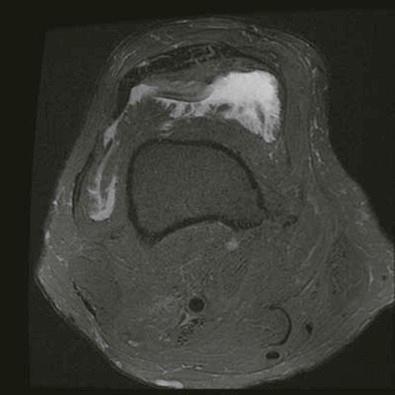
Grossly, the lesion is composed of papillary fronds of synovium that have the glistening yellow appearance of adipose tissue ( Fig. 21-7 ).
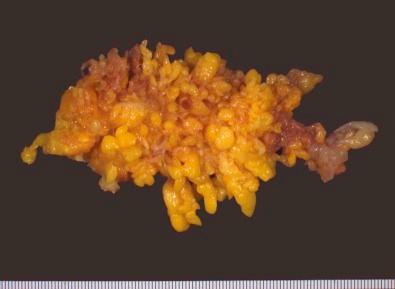
Variable amounts of fat are an integral part of the normal joint and generally admixed with fibroblasts, histiocytes, and inflammatory cells. In lipoma arborescens, however, proliferating fat extends to the synovial lining and results in grossly apparent papillary folds ( Fig. 21-8 ).
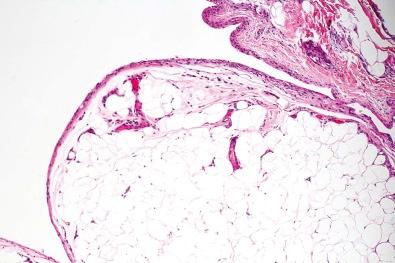
The clinicoradiologic diagnosis at the time of presentation may include intra-articular synovial lipoma, PVNS, synovial hemangioma, synovial osteochondromatosis, and RA.
True synovial lipoma is extremely rare, with only a few cases described in the literature, primarily as case reports. In contrast to the diffuse fatty infiltration of subsynovial tissue seen in lipoma arborescens, intra-articular synovial lipoma is a more localized process and presents as a single encapsulated mass.
PVNS can be recognized and separated radiographically by low signal intensity in both T1- and T2-weighted images due to the presence of hemosiderin. Furthermore, on microscopic examination, the absence of the multinucleated giant cells and monocytes typically seen in PVNS aids in differentiating these two entities. Other diagnostic considerations, including diffuse synovial hemangioma, synovial osteochondromatosis, and RA can be easily excluded by routine microscopy.
Lipoma arborescens appears to be a reactive, non-neoplastic process. Although chromosomal aberrations are well described in true lipomas of soft tissue, there are no reported cases in the English language literature of karyotypic evaluation for lipoma arborescens.
Symptomatic lipoma arborescens can be treated medically, using intra-articular injection of steroids or radioactive compounds such as yttrium 90. If symptoms recur or fail to resolve, complete excision is recommended.
Become a Clinical Tree membership for Full access and enjoy Unlimited articles
If you are a member. Log in here